An Interview with a Veteran of the China-Burma-India (CBI) Theater of World War II
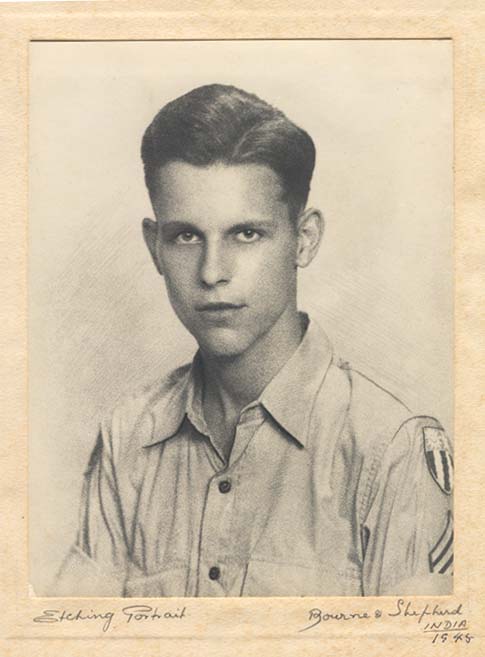

Ben's War Record
Ben's WWII Itinerary and
Dateline
Ben's Circumnavigation of
the Globe
Maps
Photo Gallery
CBI Links Page
I graduated from high school in 1940. That summer I campaigned for Dad, and in September I started at A&M. At the start, I majored in Mechanical Engineering. I went that full freshman year, and part of my sophomore year. During that sophomore year in 1941, I was living in that project house about three blocks north of North Gate. The war started in December 1941. They put A&M on a three-semester situation: three four-month semesters instead of two five-month semesters with summer school. It was during the time that I was home after that spring semester, May 15 of 1942 I think (there was a two week period of time before I was supposed to start back again into my junior year) that Mama had a stroke and almost died. For about six weeks, she could have gone either way. Well, I couldn’t go back to school in that situation, and of course the war going full blast. So I told Dad, when it looked like she was going to make it, it was too late to get back in school now for this semester, so I think I’ll just go ahead and enlist in the Air Force, which I did (It was called the U.S. Army Air Corps at that time. It wasn’t called the Air Force until later on - 1947). I just felt like that was the branch I wanted to be in. I hadn’t flown on an airplane before. I really wasn’t too interested in the flying part of it. It was just the fact that I thought maybe the communications area in the Air Force would be good experience - I had read some things about it.
My cousin, William Russell Meek, and I decided we would go in and enlist together. So he came up from Houston to Palestine so we could go through the enlistment office there in Palestine. So we enlisted there on October 20, 1942. We went to Houston first and went through the Induction Station in Houston, and then went by train from Houston over to San Antonio. On that trip from Houston to San Antonio, this sergeant had this concession for little hamburgers. He must have made a million dollars selling those little hamburgers to all those guys going to San Antonio. Anyway, we got to Fort Sam Houston in San Antonio and went through the Induction Station there. We were issued our uniforms and were there about three days.
Then they put us on this troop train that went across west Texas, New Mexico, Arizona, San Bernardino California, then up through Reno and Las Vegas to Salt Lake City. We went to an Air Force basic training center called Kearns, Utah, about 17 miles outside of Salt Lake City. This is where we went through a battery of aptitude tests. For about four days there, we were taking all kinds of tests. The shipping orders came out. We had expressed our desire to go to radio school if we could, so we were right on top of the list. So we shipped out of there on two Pullmans after about two weeks stay there at Kearns.
William and I got to stay together until we got to Kansas City. I was in one Pullman, and he was in the other. We thought we were going to the same place. But when we got to Kansas City, his Pullman went to Scott Field, Illinois (outside of St. Louis) and mine went to Sioux Falls, South Dakota! (Laughs) This was in early November 1942, and we didn’t see each other again until February 1946. When he finished school at Scott Field, the same type of school, they needed a radio instructor bad and he was taken as an instructor at Scott Field, where he spent most of the war.
When I left Sioux Falls in a shipment of two Pullmans, I didn’t know where we were going. We went down through Chicago, Indianapolis, Cincinnati, Atlanta and got to Savannah, Georgia. This is where I was assigned to the outfit that I spent most of the war with - the 89th Airdrome Squadron. They informed me at that time that it was a new type of unit that was supposed to receive training here in the States. They were supposed to be able to move in behind the infantry when the infantry captured an enemy airfield, and put it into operation. They had all kinds of Air Force technical specialists assigned to us. I was in the Communications Radio Group, and we had sheet metal workers, engine mechanics, electricians, propeller specialists, everyone it takes to run an air base. When the unit was formed that summer of ’43, we got to Hunter Field in April after I graduated from radio school in Sioux Falls in the latter part of March. That summer of ’43 we were taking infantry training - going on 10 and 15 mile hikes, all kinds of goodies. (Laughs)
I had a furlough - the only furlough I had while I was in the service - in July of’43 I came home and was home for about 10 days. When I got back to Hunter Field from furlough, we were told we were going on Second Army manuevers up in Georgia, Tennessee and Kentucky. So we went by train through Chattanooga to Lebanon, Tennessee, east of Nashville. We were in tents out there in the woods. We spent most of the next couple of months there, except for some detached service up to Camp Campbell, Kentucky where I went with one gunner technician and three engine mechanics to crew this B-25 bomber that this Major in the Tennessee Air Support Command had as his private plane for flying around over the manuevers area, and he needed a temporary crew. This was my first experience with flying, on this B-25. We had a lot of fun while we were up there because we were attached to this 15th Reconnaissance Group for our rations and quarters. These guys were getting ready to go overseas right away, and they were getting them up early. About 4 in the morning, these guys would be getting ready to go on a hike. We didn’t have to do that, though. We were just attached to the unit for a place to sleep and eat. So these guys were saying, "How come these guys get to lay up there in the sack, while we’ve got to get out and walk 15 miles?" (Laughs) Anyway, we had a lot of fun.
One of the funny things that happened while I was there at Camp Campbell was when they told us they were going to have a mock gas attack, and to be prepared, we should take our gas masks everywhere we went. So we’d take them down to the flight line, to the B-25, and lay them down on the ground. There was flat country on that base, and there was this line of trees way over on the far edge of the field. One morning, I looked up, and I could see what looked like an A-20 or B-26 coming in, right on top of the trees. Boy, I mean he was mobileing - right flat coming down. And I said, "I bet that son of a gun has brought tear gas for us" and I hollered out "I think this plane’s coming and is gonna gas us!" I ran and got my gas mask, and sure enough, that’s what he did. He laid down a fog, and I was just able to get my gas mask on. Guys were really running around! It’s funny to me now, but it wasn’t funny at the time! From then on, everybody had their mask handy.
So after that detached service was over early in November ‘43, we came back by train down to Savannah, Georgia where we prepared to get ready to go overseas. On Dec. 6, ’43 at about 7:30 or 8 PM we shipped out of Hunter Field by passenger train up to Camp Patrick Henry, Virginia which was the port of embarcation. We were there about 4 or 5 days. When I would write home to the folks, the only thing I could say (as far as where I was located) was that I was "somewhere on the East Coast and the ham was mighty fine" (referring to Virginia ham). At that point, I had no idea where I was going. It was a funny feeling. I had an idea that since we were on the East Coast, that we were headed for Italy. Because this was December of ’43, and they had made the invasion of Salerno in September of ’43. The invading forces included the 36th Division, which I was in later on, in peacetime.
We were at Camp Patrick Henry for a week, getting
our
supplies and our shots. We had to take a battery of inoculations like
yellow
fever, tetanus, dengue fever, typhoid, cholera…..they really punctured
us. (Laughs) These were given mostly over 2 days time. They put us on a
train then up to the port of Newport News; the train took us right down
onto the docks, and that was where we loaded
on the Liberty Ship, William Mulholland, for our little journey across
the North Atlantic. While we were waiting on the dock to board the
ship, Red Cross ladies gave us little gray cloth bags of toilet
articles and cigarettes, as well as donuts and milk. Not knowing
our destination and being aware of the submarine activity in the
Atlantic cause more apprehension than excitement for my first
"cruise!"
We loaded on the ship about 8 o’clock one night,
and
I never will forget the First Sergeant (Gene Lilly) says, "As soon as
you stow your
gear in the hole, come back up on deck and I want to talk to you." So
when
we got back up on deck, he was saying "Now you’ve all heard about how a
lot of men get seasick when we’re out at sea. This seasickness is all
in
your head. If you THINK you’re going to get seasick, then you probably
will. But if you have a positive attitude and say ‘I’m not going to get
seasick’, then 9 chances out of 10, you’ll be in good shape." I
remember
this because, like I say, we loaded on that night and the next morning
moved out into Chesapeake Bay, and then the following morning the
convoy began
to form. When I came up on deck that morning, there were ships
everywhere,
as far as the eye could see. There were Liberty Ships and all kinds of
ships. They were getting in line, in formation. So the full convoy
pulled out on the night of December 13. On the perimeter of the convoy
were
Canadian
corvettes, American destroyers and they said (although I never got
close
enough to see it) that we had an aircraft carrier with planes available
if they were needed in case of U-boat attack.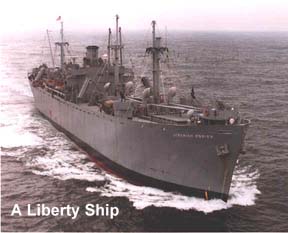
We were in the forward hold, where you went down this ladder, and they had these bunks 6 high in there that we were sleeping in. I was assigned the top bunk, with barely enough clearance under the overhead steel beam - I had to slide into it on my side. There was an engineer company that was in there with our 89th Airdrome Squadron. There were 350 men there in that forward hold, and in the back of the ship they said we had bombs and ammunition as Liberty Ship freight. In the forward hold, the bunk stacks were arranged leaving an open square in the center, where at meal time, the temporary tables were assembled. We stood at the tables, which were about chest-high, to eat. This space was also where we later had boxing matches on Christmas Day between the 89th and the combat engineers.
The severe North Atlantic winter storm we hit off Cape Hatteras sometime after midnight on the third day out was some of the most terrible stuff they’d had in a long time. I remember the vastness of the ocean, the magnitude of the swells, and the motion of riding them (as opposed to cutting through them) caused me to be quite seasick. I mean, everybody on that ship was seasick - crew and everybody. I never will forget going up to the head to "chuck my cookies" and this one sailor came running up and shoved me aside and said "Move over, buddy, sailors get sick too!"
You can’t describe the mess and smell it was. The morning that we hit that rough weather, they had trays stacked around. What they would do at mealtime was they’d put up these stands and make tables, and we were served, and then they’d take them back down, to make more room for movement in the hold. They had the aluminum food trays stacked up in the corner, and when we hit that rough weather, that whole stack of trays turned over, and boy, it sounded like a machine gun. I was in the top bunk (Laughs) and I raised up and bumped my head on the steel beam! I thought that a submarine had got us with a torpedo - that’s the first thing I thought about. Then I could tell it was just the rough seas. Man it was rough, and of course guys immediately began to get sick. To get up to this head, we had to go back up the stairway about 10 steps on either side, and this bathroom was in the middle section of the ship. Well, of course the plumbing all got stopped up, and it was just overflowing. There was about 4 inches of "water" on the floor. When the ship would roll one way, and the guys trying to relieve themselves would try to jump up, and then it would roll back to the other side. (Laughs) Oh, man, it was just horrible! You can’t imagine - I can’t even describe what a mess it was! If you weren’t sick then, if you came up to that place, you surely would be. My good buddy, Monk Winans from Catskill, NY, he was so seasick he like to died. The only thing he could keep down on his stomach for the full 21 days that we were at sea was sourball candy, real sour candy that they sold there at Camp Patrick Henry. The squadron medical officer was really worried about him, because he was getting in bad shape, and some of the others too. So we took him these sour balls, and he survived, of course.
About mid-way across the Atlantic, we developed
engine trouble of some kind and we began to drop back in the convoy
from our position of about 2nd in our line. I talked to a member
of the Mulholland's crew and he said that if we did have to turn back
(with a destroyer escort) we would go to Bermuda.
Along about late afternoon, (before sundown),
destroyers would come through the lines of the convoy giving
instructions and information by blinker light, as we were under radio
silence.
We passed through the Straits of Gibraltar, and I
got
to see the Rock of Gibraltar as we went by there. We were several miles
off the coast, but we could see it real plainly, and it looked just
like
in the commercials, we recognized the shape. That night, on the Liberty
Ship in the Mediterranean before we got to Oran, I really enjoyed - you
could
get in the bow of the ship and look at the water where the prow of the
ship was cutting through the water looked like DIAMONDS - you know,
just
sparkling. Anyway, we arrived at Oran, the port in Algiers there where
we docked, and then they took our group out to a little camp about 10
miles
from town, and we were there for 3 weeks. Boy, you would get cold at
night,
because you were right there on the Mediterranean coast, and then
hotter
than blazes in the daytime. I got a cold, and it kept getting a little
worse, and a little worse, and I kept going on sick call. Finally I
started
running fever. The squadron doctor told me "If you come back on sick
call
tomorrow, I’m going to put you in the hospital." Because of that fever.
Well, I knew that if I went in the hospital, I’d be taken from my unit
- they’d move on, and I’d be assigned somewhere else and separated from
my friends.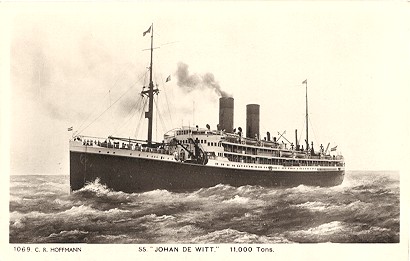
I just proceeded to take aspirin - we had plenty of
aspirin
- but it didn’t really help too much. I just kept getting worse and
worse.
Anyway, they said we were going to be moving, shipping out, so they
hauled
us by truck into Oran and we loaded onto a little train in boxcars that
in World War I they gave them the name "forty and eights" - forty men
or
eight horses. So we went by train 2 days and one night over to Algiers,
and they put us in another tent city for three nights there on the
coast.
And of course my cold just kept getting worse. I didn’t go on sick
call.
So then we trucked down to the port of Algiers and loaded on another
transport
- an old Dutch luxury liner, the Johann DeWitt - that the British had
gotten
out of Amsterdam, Holland just ahead of the Germans and made a troop
ship
out of it, if you can call it that. It was really horrible living
conditions.
They had two commodes for 350 men. And the very first night that we
were
on that thing, a lot of guys came down with the GI’s - diarrhea - and
it
was the biggest mess you ever saw. Guys would be standing in line, and
then see that they weren’t going to make it, and then just run up on
deck
and hang it over the side (laughs) - they had a wooden rail. They next
morning the side of that transport was just brown. It was serious, and
you couldn’t keep from worrying about it, but you couldn’t keep from
laughing
at the same time. You’d see a guy standing in line, and he would stand
there as long as he could, and then he’d take off up the stairs! It was
terrible!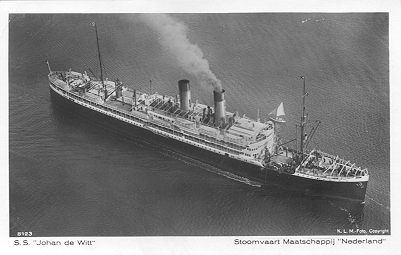
Once the ship cleared the harbor that first night, I went on sick call, because I knew they’d have to take me then - the convoy was already moving. I walked through the door of this sick bay there and this Captain Metzler, the squadron surgeon, he said "You’re going to bed!" I said "I know it, I feel like it too!" And then we moved on down through the Mediterranean toward the Suez Canal, and of course the Germans still had an airbase on Crete, and that was a big worry. But boy, we hit bad weather, and it was welcome, because we knew the weather was so bad that the Germans couldn’t fly in that kind of weather anyway, so bring on the bad weather!
They had three rows of double-decker bunks in this sick bay, and I was in the top bunk of the one next to the wall on the porthole side. They had a row of these double-deckers in the middle of this wooden floor of this old ship, and they were just screwed to the floor. Boy, when we hit this rough weather with the ship rolling from side to side, and it didn’t take long for those screws in that middle row of bunks to pull loose. This one old boy on the top middle bunk right across from me saw his bunk was going over, and he just jumped over on top of me! (laughs)
The Navy medical corpsman that was in charge of the sick bay - the door slammed shut on his arm and broke his arm. The pill cabinet turned over - boy, it looked like snow in there on the floor - pills all over the place in there. But by this time I was beginning to feel a little better. After about 5 days we arrived at Port Said there at the Suez Canal. I was released from sick bay, thank goodness, so I was able to go up on deck as we entered the Suez Canal. It took us one day, one night, and part of another day to get through the Suez and down into the Red Sea. Then we refueled at Aden down at the foot of the Arabian peninsula and spent part of a day there in that harbor, and then we took off again. There were three transports with escorts, and we didn’t know where we were going then. But when we were out in the Arabian Sea, we found out we were headed to Bombay. About a month after we reached the harbor at Bombay, another troop ship was involved in a terrible explosion there and a lot of guys were killed.
But anyway, we were quartered there in Bombay in a British RAF containment area there on the edge of town, and we spent about 15 days there while they were trying to decide what they were going to do with us, because by this time we realized that we weren’t going into Italy!
We had left Virginia on Dec. 13, 1943; we arrived in Oran on Jan. 5 or 6, 1944; we left Oran about Jan. 31, 1944; and arrived in Bombay Feb. 25, 1944. So we were about 70 days at sea.
Then we went by train from Bombay to Karachi - they
swung
us out to New Delhi and then down. We were on the troop train about a
week.
These were British style train coaches, and they were pretty
comfortable,
although they weren’t air conditioned or anything.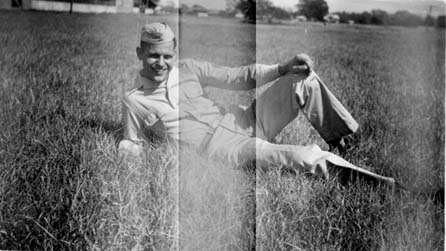
Anyway, we were put in this containment area there just outside of Karachi where General Montgomery trained his 8th Army - a desert training center. They were nice barracks, but the living conditions were bad - lots of dirt and sand. We weren’t there but a couple of weeks and then they split our outfit up and decided they didn’t need the 89th Airdrome Squadron as a unit, but they needed various technicians all over India in the Air Transport Command. So some of our radio operators went to Dum-Dum at Calcutta; some of them went to Agra; some of them went to Lal Hat, where I was; some of them went to Chabua; just all over. They just divided us up because they needed radio operators real bad, and here we had had no flight training to speak of, except that detached service that I had at Camp Campbell, KY on the B-25. So now we were flight radio operators by the time we arrived.
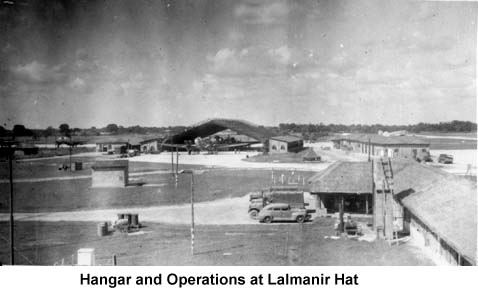 My
time was not near as bad as some of the guys over in China, because all
we had to do was to fly empty from our base at Lal Hat (about 350 miles
north of Calcutta, where the Brahmaputra River makes a big turn and
goes
up the Assam Valley), to Calcutta in C-47’s and C-46’s, the type plane
we had, pick up our freight there and then fly in a northeasterly
direction
up over the North Burma Hills to what we called a "Hump Station", where
the larger planes would fly the freight on into China - "over the
Hump".
We called it "Flying Around the Horn".
My
time was not near as bad as some of the guys over in China, because all
we had to do was to fly empty from our base at Lal Hat (about 350 miles
north of Calcutta, where the Brahmaputra River makes a big turn and
goes
up the Assam Valley), to Calcutta in C-47’s and C-46’s, the type plane
we had, pick up our freight there and then fly in a northeasterly
direction
up over the North Burma Hills to what we called a "Hump Station", where
the larger planes would fly the freight on into China - "over the
Hump".
We called it "Flying Around the Horn". 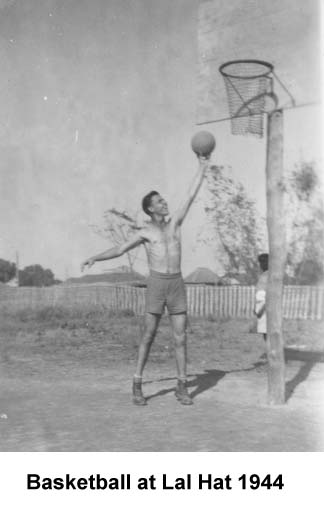
Of course in North Burma at that time, the Japanese were fighting the British 14th Army in North Burma and Eastern India. So we did have some alerts. I never did see a Japanese fighter, but on one trip from Calcutta to Chabua, I had to report in over each one of the ground stations, just to make sure they knew where we were and at what time. I was sitting there with my monitor and my receiver, and the message came over: "Alert - Alert - Tarezi - Red Alert!" This meant that at the next ground station that we were to pass over, the Japanese fighters were strafing. So I got on the intercom and called the pilot and I said, "We got a Red Alert at Tarezi" and boy, I no more than got the words out than I felt that thing bank and turn back to Calcutta! (laughs) Get me outta here! That pilot didn’t even wait for me to get it out of my mouth! He started banking the moment I said "Red Alert at Tarezi!" We didn’t have any guns - this was just a little Douglas DC-3 - this is what used to be the airline plane before the war, and they had made a light freight carrier out of it.
We had some funny instances happen. - in the latter
part
of the war they started putting this pipeline through from India into
Burma
and China, so they needed to fly pipe. They didn’t know exactly how
much
to haul at one time. They had pretty good calculations, they felt like,
but the first couple of flights they overloaded. So this buddy of mine
was a radio operator in there on one of these planes. I got to see the
takeoff. Normally they would come down the runway, and the tail would
come
up you know, and then the whole thing would lift off. Well, this one
came
down the runway, the front wheels lifted off, but the tail was still on
the ground! They were tail-heavy. That pilot was just barely able to
get
it up over the trees. And boy he banked around as quick as he could and
came back and landed. This old boy that was the radio operator, his
folks
had sent him a new wristwatch that he’d had for only two or three days.
He took it off and took it to that pilot and said "I want you to have
this
watch. You just saved my life!" (laughs) 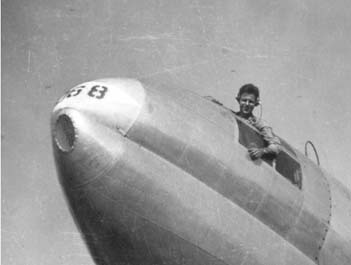
The trip from our base to Calcutta took about an hour and twenty minutes, something like that. Then from the Calcutta base up to Chabua and the other Hump Stations (there was about four: Misamari, Mohanbari, Sookerating, and Chabua - these were the Hump Stations we carried stuff to) was the longest leg of the triangle. Then we would fly back to our base.
They had our bases scattered around for dispersion - they didn’t want to get them all grouped up together. I imagine that was the reason they had them spaced. We were right where the river turned and started up the valley; then about 30 minutes flying time from us was Tezpoor; then 30 minutes on up from there was Jorhat; then on beyond Jorhat was Sookerating, Misamari, Dum Dum and Chabua.
Anyway, we lived there in Lalmanir Hat beginning
March
15, 1944. Around the 1st of April, I received a package in the mail. I
could tell from the return address that it was from Aunt Bonnie. I
said,
Good Gosh - I checked the date stamp on that package and it was
December
6, 1943. She had sent me a big box of home-made peanut butter cookies
(laughs),
and they started following me! She had mailed it when I was still at
Hunter
Field, Savannah, Georgia, then to Camp Patrick Henry, Virginia, to
Newport
News, to Oran, to Bombay, India to Lalmanir Hat, and they finally
caught
up with me the 1st of April. I opened up that box and there was just
powder
- there was no form of a cookie at all, just a big box of powder! The
powder
smelled good, but of course by that time it was getting pretty stale,
and
I couldn’t eat it. 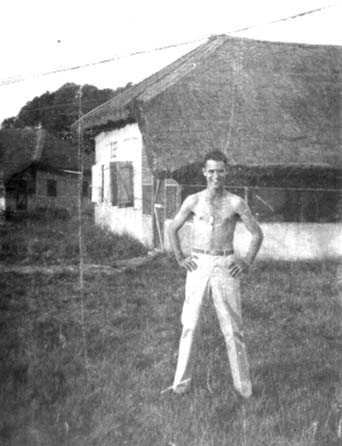
We usually made one run per day while I was on flight status there at Lalmanir Hat from March 15, 1944 to January 15, 1945. By that time I had enough time in that they give you a choice: do you want to keep flying or quit. And I said I’d had enough. So the rest of the time that I spent there until I left in the early part of November of ’45 was in radio maintenance, you know, checking radio trouble on planes that came in. We’d meet the plane, and see if they were having any problems. Any planes we were having maintenance inspections on, we would pre-flight the equipment, call the ground station, turn the radios on and check them to make sure they were working properly.
Anyway, it was quite an experience. I met a lot of
good
guys and made a lot of good friends, some of whom I’ve seen since this
reunion deal started. 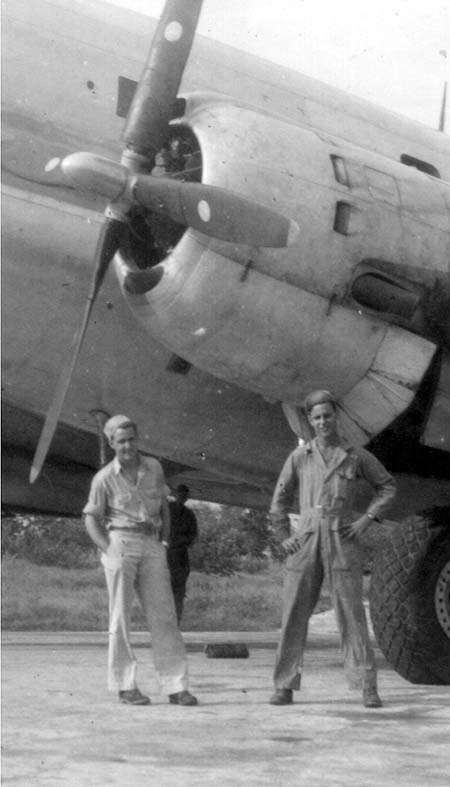
I was at Lalmanir Hat when we heard that the Japanese had surrendered. I’ve got some pictures in there from that day. Of course, we didn’t have any ice for our beer, but we had a beer ration, and boy, we put it away, as much as we had! (laughs) We really celebrated.
The Japanese in our area had been cleaned out earlier. The closest that the Japanese ever got to our base as far as physical movement was about 250 miles. So like I say, we had it soft compared to a lot of guys. We didn’t have to fight on the ground, and our particular crews didn’t have any problems in the air except during the early part of the time, when we might have an alert about Japanese fighters in the area. You wondered when you were going to get that - the mystery about what could happen. But by about the latter part of August or the middle of September, the 10th Air Force had pretty well taken care of the Japanese Air Force in Burma and India. The Japanese never had ground troops in our area.
When I left in November, they shipped us to a depot
just
outside of Calcutta for about 10 days. Then around the 1st of December
they shipped us on over to Karachi again to this same place where we
had
been when we first got off the train. We spent the month of December
waiting
on a ship that had availability to take us home. On January 6, 1946,
they
said "The General A.W. Greeley is ready to go, sitting at dockside.
We’ll
load into trucks in the morning and be ready to go." Boy, that was a
happy
day! 
So we sailed from the port of Karachi on the General A.W. Greeley, a naval transport that was about 3 times as big as that Liberty Ship. We had about 3,200 men on the transport coming home. Carl Lininschmidt had an old box camera and we took some pictures coming home. We sailed down to the port of Columbo, Ceylon down at the tip of India, and then across the Indian Ocean through the Straits of Malacca to Singapore. We spent one day in the harbor there at Singapore - we didn’t get to get off the ship, but I could see the town from the ship. Then we moved out into the South China Sea and went through some of the areas where big naval battles had taken place less than a year before when they were coming back into the Philippines: the battle of Suriago Strait, where the Japanese tried to get through there and the American battleships "crossed the T". They had heard ahead of time that the Japs were coming through there, and they lined these battleships up across this strait, and as the Japs came sailing up that thing to go through, boy, they let ‘em have it!
We moved through there and on around to Leyte, the first landing spot in the Philippines, and refueled there, I think. Then we left there and moved out around the southern end of the island of Samar. We thought first we might get to go back through the Hawaiian Islands; we heard all kinds of rumors about where we were going and when we would get there. We were hoping that we might go that route, through Hawaii to San Francisco or Los Angeles. But the second day out of Leyte, they said no, we’re not doing that, we’re going to take the northern route. That meant that we would sail between Iwo Jima, the island where there was such a bloody battle, and Guam, and then go north of the Hawaiian Islands and come in to Seattle, which is what we did.
We came in through the Strait of Juan de Fuca, took on a pilot at Port Angeles, which is just across the bay from Anacortes. This was on the 2nd of February, 1946. It was cold, and snow was on the ground. As we came down Puget Sound, headed for Pier 39 in Seattle where we were going to dock, they had this Welcome Home committee with girls at the University of Washington that were the some of the performers. They had this deck built up on this smaller ship, a platform where the girls would come out and dance, and you can imagine what happened on that troop ship. Everybody ran over to that one side, and here we come listing about 20 degrees to port! These GIs were about to go crazy - they hadn’t seen an American woman in so long - you can imagine the hollering and carrying on. (laughs)
So we moved on down Puget Sound and docked at Pier 39. When we got off the ship at this shed-like place, the American Red Cross came around and were distributing a pint of milk and 2 donuts to everybody. Of course we had all our gear on and everything. They loaded us into these moving trucks. They just opened the tailgate and run us up in there. They took us out to Fort Lawton, right there on the Bay of Seattle. It was sort of a stopover place, and that was where we had our traditional first meal. You talk about putting on the feed bag! They had steak and ice cream and pie, everything you could think of, and all you wanted. One funny thing - as we went through the line, old Carl Lininschmidt, my buddy from Denton, who was German, and he could speak German. Well, they had German prisoners of war working in the mess hall, serving and cooking. And old Lininschmidt started talking German to them, and they took care of him! One guy watched where we sat down, and he came out with some more steak (laughs), so he was really taking care of his German buddies.
We spent the night there at Fort Lawton, and the next day about 2 in the afternoon they put us back on trucks again and took us down to the railroad station and put us on a troop train, fixed up especially for carrying troops. We headed for Fort Bliss in El Paso. We went down through Pendleton, Oregon; Napa and Pocatello, Idaho; Laramie and Cheyenne, Wyoming; then turned south to Denver and got into Denver about 9:30 the next night. Then the next morning I looked out to see where we were and we were in Dalhart, Texas. Then we cut back in New Mexico through Tucumcari and headed south to El Paso. We got into Fort Bliss on about the 6th of February. We were there three days for discharging. I was discharged on February 9th, and I caught the train to Palestine.
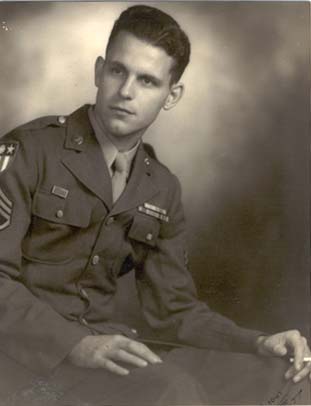 I
got off the train at Palestine, and an old boy that I’d gone to school
with at Slocum was on this same shipment that I was, and we had been
discharged
the same day at Fort Bliss, and we got off the train in Palestine about
4:00 in the morning, and of course the town was just dead. The first
thing
we did was go over to the YMCA and take a shower! The YMCA was just
right
across from the station back then. Then we went over to the White House
café where the railroad men ate, and had scrambled eggs and ham.
I had sent the folks a telegram and told them that I’d probably be home
sometime Monday or Tuesday, but I didn’t know when. So anyway, Dad
always
got up and cooked breakfast you know, so I caught a taxi and got home
just
as he was cooking biscuits for breakfast.
I
got off the train at Palestine, and an old boy that I’d gone to school
with at Slocum was on this same shipment that I was, and we had been
discharged
the same day at Fort Bliss, and we got off the train in Palestine about
4:00 in the morning, and of course the town was just dead. The first
thing
we did was go over to the YMCA and take a shower! The YMCA was just
right
across from the station back then. Then we went over to the White House
café where the railroad men ate, and had scrambled eggs and ham.
I had sent the folks a telegram and told them that I’d probably be home
sometime Monday or Tuesday, but I didn’t know when. So anyway, Dad
always
got up and cooked breakfast you know, so I caught a taxi and got home
just
as he was cooking biscuits for breakfast.
See more photos relating to Ben's military service on the PHOTO GALLERY PAGE